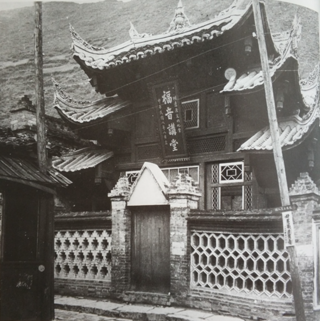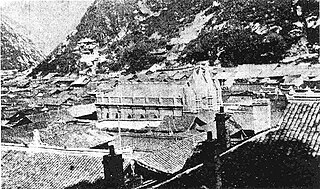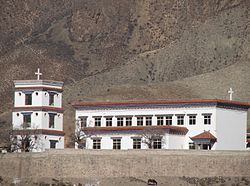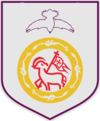
Évariste Régis Huc, C.M., also known as the Abbé Huc (1813–1860), was a French Catholic priest, Lazarite missionary, and traveller. He became famous for his accounts of Qing-era China, Mongolia, and especially the then-almost-unknown Tibet in his book Remembrances of a Journey in Tartary, Tibet, and China. He and his companion Joseph Gabet were the first Europeans who had reached Lhasa since Thomas Manning in 1812.

Shangri-La is a fictional place in Tibet's Kunlun Mountains, described in the 1933 novel Lost Horizon by English author James Hilton. Hilton portrays Shangri-La as a mystical, harmonious valley, gently guided from a lamasery, enclosed in the western end of the Kunlun Mountains. Shangri-La has become synonymous with any earthly paradise, particularly a mythical Himalayan utopia – an enduringly happy land, isolated from the world. In the novel, the people who live in Shangri-La are almost immortal, living hundreds of years beyond the normal lifespan and only very slowly aging in appearance.

Batang County is a county located in western Garzê Tibetan Autonomous Prefecture, Sichuan Province, China. The main administrative centre is known as Batang Town.

The Roman Catholic Diocese of Kangding is a Latin Catholic diocese in the ecclesiastical province of the Metropolitan of Chongqing in western China, but still dependent on the Congregation for the Evangelization of Peoples.

The main religion in Tibet has been Buddhism since its outspread in the 8th century AD. As of 2022 the historical region of Tibet is mostly comprised in the Tibet Autonomous Region (TAR) of China and partly in the Chinese provinces of Qinghai and Sichuan. Before the arrival of Buddhism, the main religion among Tibetans was an indigenous shamanic and animistic religion, Bon, which would later influence the formation of Tibetan Buddhism and still attracts the allegiance of a sizeable minority of Tibetans.

Félix Biet, MEP was a French Catholic prelate who served as the Apostolic Vicar of Tibet from 1878 to 1901. He was a member of the Paris Foreign Missions Society and also a naturalist.

Auguste Desgodins, MEP was a French member of the Paris Foreign Missions Society who attempted to enter into Tibet in the early 1860s.
Joseph Gabet was a French Catholic Lazarite missionary. He was active in Northern China and Mongolia before traveling to Tibet with Évariste Huc. Expelled and arrested, he died in Rio de Janeiro, Brazil.

Jean-André Soulié, MEP was a French Catholic missionary sent to East Tibet of Qing China. He was killed in a 1905 anti-Catholic revolt. He was a member of the Paris Foreign Missions Society.
There are multiple churches known as Our Lady of the Sacred Heart Church, including:

Maurice Tornay, CRSA was a Swiss Catholic priest of the Canons Regular of Saint Augustine – of the Hospitallers of Saint Nicholas and Grand-St-Bernard of Mont Joux branch – who served as part of the missions in China and Tibet.

The Catholic Church of Lhasa Also called the Lhasa Chapel, was the first Catholic church in Tibet in China. It was founded in 1726 and disappeared in 1745.

Gospel Church, today known as Kangding Christian Church, is a Protestant church situated on Guangming Road, Kangding, a county-level city in Garzê Tibetan Prefecture, Sichuan Province. First built in 1905, on Yanhe West Road, by China Inland Mission missionaries, the church was relocated to its present location in 1958. It has been subjected to the control of the state-sanctioned Three-Self Patriotic Church since 1954.

The presence of the Catholic Church in the southwestern Chinese province of Sichuan and city of Chongqing dates back to 1640, when two missionaries, Lodovico Buglio and Gabriel de Magalhães, through Jesuit missions in China, entered the province and spent much of the 1640s evangelizing in Chengdu and its surrounding areas.

Sacred Heart Church or Sacred Heart of Jesus Church, commonly known as Zhongding Catholic Church, is a Catholic church in Bingzhongluo, Gongshan, Yunnan, China. It was founded by Annet Genestier in 1908, destroyed during the Cultural Revolution, and rebuilt in 1996. It has been subjected to the government-controlled Catholic Patriotic Association since 1957.

Sacred Heart Church, Madagondapall, is one of the earliest Catholic churches within the Dharmapuri Diocese, boasting a 141-year legacy. For over 94 years, it has served as a parish church, offering a sacred space for Catholics to gather in worship.

The Catholic Church is a minority religious organization in Tibet, where Tibetan Buddhism is the faith of the majority of people. Its origin dates from the 17th century, when António de Andrade, a Portuguese Jesuit through Jesuit missions in Tibet, introduced Catholicism into the Kingdom of Guge in western Tibet.

Nicolas Michel Krick was a priest from Lorraine who became a missionary with the Paris Foreign Missions Society in 1848. He was murdered with Augustin Bourry while attempting to reach Tibet.

Yangliujie Catholic Church is a former Catholic church in Zunyi, Guizhou, China. It was completed in 1897 after several anti-Christian riots in Zunyi in the 19th century. On the course of the Long March, the Chinese Red Army used the church to host its political directorate during the Zunyi Conference in January 1935. It was given to the local government in 1951, renovated, and opened to the general public in 1985 as a part of the site of the Zunyi Conference.

St. Anne's Church, commonly referred to as Moxi Catholic Church, is a Catholic church in the Sichuanese Tibetan town of Moxi, southwestern China. The church was built in the late 19th century by Paris Foreign Missions Society, and was renovated and expanded in 1930. Originally housing the mission of Moxi, it has been controlled by the state-sanctioned Chinese Catholic Patriotic Association since 1957.




















